Cymbeline

Cymbeline /ˈsɪmbᵻliːn/, also known as Cymbeline, King of Britain, is a play by William Shakespeare, set in Ancient Britain and based on legends that formed part of the Matter of Britain concerning the early Celtic British King Cunobeline. Although listed as a tragedy in the First Folio, modern critics often classify Cymbeline as a romance or even a comedy. Like Othello and The Winter's Tale, it deals with the themes of innocence and jealousy. While the precise date of composition remains unknown, the play was certainly produced as early as 1611.[1]
Characters
- In Britain
- Cymbeline – King of Britain
- Queen – Cymbeline's second wife
- Imogen/Innogen[2] – Cymbeline's daughter by a former queen, later disguised as the page Fidele
- Posthumus Leonatus – Innogen's husband
- Cloten – Queen's son by a former husband
- Belarius – banished lord living under the name Morgan
- Guiderius – Cymbeline's son, kidnapped in childhood by Belarius and raised as his son Polydore
- Arvirargus – Cymbeline's son, kidnapped in childhood by Belarius and raised as his son Cadwal
- Pisanio – Posthumus' servant
- Cornelius – court physician
- Helen – lady attending Imogen
- Two Lords attending Cloten
- Two Gentlemen
- Two Captains
- Two Jailers
- In Rome
- Philario – Posthumus' host in Rome
- Iachimo/Giacomo[2] – Philario's friend
- French Gentleman
- Dutch Gentleman
- Spanish Gentleman
- Caius Lucius – Roman ambassador and later general
- Two Roman senators
- Roman tribunes
- Roman captain
- Philharmonus – soothsayer
- Apparitions
- Jupiter – King of the Gods
- Sicilius Leonatus – Posthumus' father
- Posthumus' mother
- Posthumus' two brothers
Synopsis
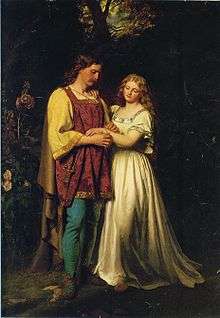
Cymbeline, the Roman Empire's vassal king of Britain, once had two sons, Guiderius and Arvirargus, but they were stolen twenty years earlier as infants by an exiled traitor named Belarius. Cymbeline now discovers that his only child left, his daughter Imogen (or Innogen), has secretly married her lover Posthumus Leonatus, an otherwise honourable man of Cymbeline's court. The lovers have exchanged jewellery as tokens: Imogen now with a bracelet, and Posthumus with a ring. Cymbeline dismisses the marriage and banishes Posthumus, since Imogen, as Cymbeline's only child, must produce a fully royal-blooded heir to succeed to the British throne. In the meantime, Cymbeline's Queen is conspiring to have Cloten, her cloddish and arrogant son by an earlier marriage, married to Imogen, to secure her bloodline. The Queen is also plotting to murder both Imogen and Cymbeline, procuring what she believes to be deadly poison from the court doctor, Cornelius, who, suspicious, switches the poison with a harmless sleeping potion. The Queen passes the "poison" along to Pisanio, Posthumus and Imogen's loving servant, who is led to believe it is a medicinal drug. No longer able to be with her banished Posthumus, Imogen secludes herself in her chambers, away from Cloten's aggressive advances.
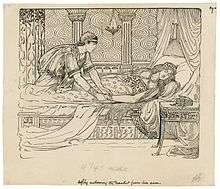
Posthumus must now live in Italy, where he meets Iachimo (or Giacomo), who challenges the prideful Posthumus to a bet that he, Iachimo, can seduce Imogen, who Posthumus has praised for her chastity, and then bring Posthumus proof of Imogen's adultery. If Iachimo wins, he will get Posthumus's token ring. If Posthumus wins, not only must Iachimo pay him but also fight Posthumus in a duel with swords. Iachimo heads to Britain where he aggressively attempts to seduce the faithful Imogen, who sends him packing. Iachimo then hides in a chest in Imogen's bedchamber and, when the princess falls asleep, emerges to steal from her Posthumus's bracelet. He also takes note of the room and Imogen's partly naked body to be able to present false evidence to Posthumus that he has seduced his bride. Returning to Italy, Iachimo convinces Posthumus that he has successfully seduced Imogen. In his wrath, Posthumus sends two letters to Britain: one to Imogen, telling her to meet him at Milford Haven, on the Welsh coast; the other to the servant Pisanio, ordering him to murder Imogen at the Haven. However, Pisanio refuses to kill Imogen and reveals to her Posthumus's plot. He has Imogen disguise herself as a boy and continue to Milford Haven to seek employment. He also gives her the Queen's "poison," believing it will alleviate her psychological distress. In the guise of a boy, Imogen adopts the name "Fidele," meaning "faithful."

Back at Cymbeline's court, Cymbeline refuses to pay his British tribute to the Roman ambassador Caius Lucius, and Lucius warns Cymbeline of the Roman Emperor's forthcoming wrath, which will amount to an invasion of Britain by Roman troops. Meanwhile, Cloten learns of the "meeting" between Imogen and Posthumus at Milford Haven. Dressing himself enviously in Posthumus's clothes, he decides to go to Wales to kill Posthumus, and then rape, abduct, and marry Imogen. Imogen has now been travelling as "Fidele" through the Welsh mountains, her health in decline as she comes to a cave: the home of Belarius, along with his "sons" Polydore and Cadwal, whom he raised into great hunters. These two young men are in fact the British princes Guiderius and Arviragus, who themselves do not realise their own origin. The men discover "Fidele," and instantly captivated by a strange affinity for "him" become fast friends. Outside the cave, Guiderius is met by Cloten, who throws insults, leading to a sword fight during which Guiderius beheads Cloten. Meanwhile, Imogen's fragile state worsens and she takes the "poison" as a hopeful medicine; when the men re-enter, they find her "dead." They mourn and, after placing Cloten's body beside hers, briefly depart to prepare for the double burial. Imogen awakes to find the headless body, and believes it to be Posthumus due to the fact the body is wearing Posthumus' clothes. Lucius' Roman soldiers have just arrived in Britain and, as the army moves through Wales, Lucius discovers the devastated "Fidele", who pretends to be a loyal servant grieving for his killed master; Lucius, moved by this faithfulness, enlists "Fidele" as a pageboy.
The treacherous Queen is now wasting away due to the disappearance of her son Cloten. Meanwhile, despairing of his life, a guilt-ridden Posthumus enlists in the Roman forces as they begin their invasion of Britain. Belarius, Guiderius, Arviragus, and Posthumus all help rescue Cymbeline from the Roman onslaught; the king does not yet recognise these four, yet takes notice of them as they go on to fight bravely and even capture the Roman commanders, Lucius and Iachimo, thus winning the day. Posthumus, allowing himself to be captured, as well as "Fidele", are imprisoned alongside the true Romans, all of whom await execution. In jail, Posthumus sleeps, while the ghosts of his dead family appear to complain to Jupiter of his grim fate. Jupiter himself then appears in thunder and glory to assure the others that destiny will grant happiness to Posthumus and Britain.

Cornelius arrives in the court to announce that the Queen has died suddenly, and that on her deathbed she unrepentantly confessed to villainous schemes against her husband and his throne. Both troubled and relieved at this news, Cymbeline prepares to execute his new prisoners, but pauses when he sees "Fidele," whom he finds both beautiful and somehow familiar. "Fidele" has noticed Posthumus' ring on Iachimo's finger and abruptly demands to know from where the jewel came. A remorseful Iachimo tells of his bet, and how he could not seduce Imogen, yet tricked Posthumus into thinking he had. Posthumus then comes forward to confirm Iachimo's story, revealing his identity and acknowledging his wrongfulness in desiring Imogen killed. Ecstatic, Imogen throws herself at Posthumus, who still takes her for a boy and knocks her down. Pisanio then rushes forward to explain that "Fidele" is Imogen in disguise; Imogen still suspects that Pisanio conspired with the Queen to give her the poison. Pisanio sincerely claims innocence, and Cornelius reveals how the poison was a non-fatal potion all along. Insisting that his betrayal years ago was a set-up, Belarius makes his own happy confession, revealing Guiderius and Arviragus as Cymbeline's own two long-lost sons. With her brothers restored to their place in the line of inheritance, Imogen is now free to marry Posthumus. An elated Cymbeline pardons Belarius and the Roman prisoners, including Lucius and Iachimo. Lucius calls forth his soothsayer to decipher a prophecy of recent events, which ensures happiness for all. Blaming his manipulative Queen for his refusal to pay earlier, Cymbeline now agrees to pay the tribute to the Roman Emperor as a gesture of peace between Britain and Rome, and he invites everyone to a great feast.
Sources
The plot of Cymbeline is based on a tale in the chronicles of Raphael Holinshed and is ultimately part of the Matter of Britain, derived from the part of the Historia Regum Britanniae of Geoffrey of Monmouth about the real-life British monarch Cunobeline. Shakespeare, however, freely adapts the legend and adds entirely original sub-plots. Iachimo's wager and subsequent hiding-place inside a chest in order to gather details of Imogen's room derive from story II.9 of Giovanni Boccaccio's Decameron.[3][4]
Date and text
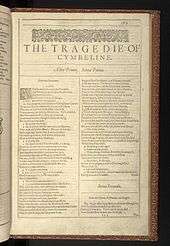
The first recorded production of Cymbeline, as noted by Simon Forman, was in April 1611.[5] It was first published in the First Folio in 1623. When Cymbeline was actually written cannot be precisely dated.
The Yale edition suggests a collaborator had a hand in the authorship, and some scenes (e.g. Act III scene 7 and Act V scene 2) may strike the reader as particularly un-Shakespearean when compared with others. The play shares notable similarities in language, situation and plot with Beaumont and Fletcher's tragicomedy Philaster, or Love Lies a-Bleeding, (c.1609–10). Both plays concern themselves with a princess who, after disobeying her father in order to marry a lowly lover, is wrongly accused of infidelity and thus ordered to be murdered, before escaping and having her faithfulness proven. Furthermore, both were written for the same theatre company and audience.[6] Some scholars believe this supports a dating of approximately 1609, though it is not clear which play preceded the other.[7]
The editors of the Oxford and Norton Shakespeare believe the name of Imogen is a misprint for Innogen—they draw several comparisons between Cymbeline and Much Ado About Nothing, in early editions of which a ghost character named Innogen was supposed to be Leonato's wife (Posthumus being also known as "Leonatus", the Latin form of the Italian name in the other play). Stanley Wells and Michael Dobson point out that Holinshed's Chronicles, which Shakespeare used as a source, mention an Innogen, and that Forman's eyewitness account of the April 1611 performance refers to "Innogen" throughout.[5] In spite of these arguments, most editions of the play have continued to use the name Imogen and it has been suggested that 'Imogen' may be intended to evoke the figure of 'Innogen' but that the slight change in name is deliberate as there are other characters in the play whose names appear to be slight variants of historical or pseudo-historical figures.[8]
Reputation
Though once held in very high regard, Cymbeline lost favour with critics in the 18th century. The most famous comments were made by Samuel Johnson:
This play has many just sentiments, some natural dialogues, and some pleasing scenes, but they are obtained at the expense of much incongruity. To remark the folly of the fiction, the absurdity of the conduct, the confusion of the names and manners of different times, and the impossibility of the events in any system of life, were to waste criticism upon unresisting imbecility, upon faults too evident for detection, and too gross for aggravation.[9]
Lytton Strachey famously found it "difficult to resist the conclusion that he [Shakespeare] was getting bored himself. Bored with people, bored with real life, bored with drama, bored, in fact, with everything except poetry and poetical dreams."[10] Harley Granville-Barker had similar views, saying that the play shows that Shakespeare was becoming a "wearied artist".[10]
William Hazlitt and John Keats, however, numbered it among their favourite plays.
Some have taken the convoluted plot as evidence that the play deliberately parodies its own content. Harold Bloom says "Cymbeline, in my judgment, is partly a Shakespearean self parody; many of his prior plays and characters are mocked by it."[11] In Act V Scene IV, "Jupiter descends in thunder and lightning, sitting upon an eagle: he throws a thunderbolt." After stating that Posthumus' fortunes will improve, Jupiter returns to heaven on his eagle. In one scene, a character seems to say that a plot point is to be "laughed at". When it is explained how the king's children were abducted, a minor character adds, "the negligence may well be laughed at, Yet is it true, sir."[12]
Performance history
Following the performance mentioned by Forman, the play was revived at court for Charles I and Henrietta Maria in 1634.[13] In the Restoration era, Thomas D'Urfey staged an adaptation of Cymbeline, titled The Injur'd Princess, or The Fatal Wager. John Rich staged the play with his company at Lincoln's Inn Fields; the performance was not long-remembered, as Rich's company was less famous for its work with Shakespeare than for its pantomimes and spectacles. Theophilus Cibber revived Shakespeare's text in 1758. In November 1761, David Garrick returned to a more-or-less original text, with good success: Posthumus became one of his star roles.[14] Garrick rearranged some scenes; in particular, he shortened Imogen's burial scene and the entire fifth act, omitting the dream of Posthumus. The production was highly praised.
The play entered the Romantic era with John Philip Kemble's company in 1801.[15] Kemble's productions made use of lavish spectacle and scenery; one critic noted that during the bedroom scene, the bed was so large that Jachimo all but needed a ladder to view Imogen in her sleep.[16] Kemble added a dance to Cloten's comic wooing of Imogen. In 1827, his brother Charles mounted an antiquarian production at Covent Garden; it featured costumes designed after the descriptions of the ancient British by such writers as Julius Caesar and Diodorus Siculus.
William Charles Macready mounted the play several times between 1837 and 1842.[17] At the Theatre Royal, Marylebone, an epicene production was staged with Mary Warner, Fanny Vining, Anna Cora Mowatt, and Edward Loomis Davenport.
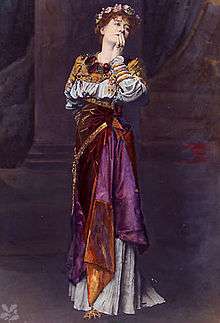
In 1864, as part of the celebrations of Shakespeare's birth, Samuel Phelps performed the title role at Theatre Royal, Drury Lane. Helena Faucit returned to the stage for this performance.
The play was also one of Ellen Terry's last performances with Henry Irving at the Lyceum in 1896. Terry's performance was widely praised, though Irving was judged an indifferent Iachimo. Like Garrick, Irving removed the dream of Posthumus; he also curtailed Iachimo's remorse and attempted to render Cloten's character consistent. A review in the Athenaeum compared this trimmed version to pastoral comedies such as As You Like It. The set design, overseen by Lawrence Alma-Tadema, was lavish and advertised as historically accurate, though the reviewer for the time complained of such anachronisms as gold crowns and printed books as props.[18]
Similarly lavish but less successful was Margaret Mather's production in New York in 1897. The sets and publicity cost $40,000, but Mather was judged too emotional and undisciplined to succeed in a fairly cerebral role.
Barry Jackson staged a modern dress production for the Birmingham Rep in 1923, two years before his influential modern dress Hamlet.[19] Walter Nugent Monck brought his Maddermarket Theatre production to Stratford in 1946, inaugurating the post-war tradition of the play.
London saw two productions in the 1956 season. Michael Benthall directed the less successful production, at The Old Vic. The set design by Audrey Cruddas was notably minimal, with only a few essential props. She relied instead on a variety of lighting effects to reinforce mood; actors seemed to come out of darkness and return to darkness. Barbara Jefford was criticised as too cold and formal for Imogen; Leon Gluckman played Posthumus, Derek Godfrey Iachimo, and Derek Francis Cymbeline. Following Victorian practice, Benthall drastically shortened the last act.[20]

By contrast, Peter Hall's production at the Shakespeare Memorial presented nearly the entire play, including the long-neglected dream scene (although a golden eagle designed for Jupiter turned out too heavy for the stage machinery and was not used).[21] Hall presented the play as a distant fairy tale, with stylised performances. The production received favourable reviews, both for Hall's conception and, especially, for Peggy Ashcroft's Imogen.[22] Richard Johnson played Posthumus, and Robert Harris Cymbeline. Iachimo was played by Geoffrey Keen, whose father Malcolm had played Jachimo with Ashcroft at the Old Vic in 1932.[23]
Hall's approach attempted to unify the play's diversity by means of a fairy-tale topos. The next major Royal Shakespeare Company production, in 1962, went in the opposite direction. Working on a set draped with heavy white sheets, director William Gaskill employed Brechtian alienation effects, to mixed critical reviews. Bernard Levin complained that the bare set deprived the play of necessary scenic splendor.[24] The acting, however, was widely praised. Vanessa Redgrave as Imogen was often compared favourably to Ashcroft; Eric Porter was a success as Jachimo, as was Clive Swift as Cloten. Patrick Allen was Posthumus, and Tom Fleming played the title role.
A decade later, John Barton's 1974 production for the RSC (with assistance from Clifford Williams) featured Sebastian Shaw in the title role, Tim Pigott-Smith as Posthumus, Ian Richardson as Jachimo, and Susan Fleetwood as Imogen. Charles Keating was Cloten. As with contemporary productions of Pericles, this one used a narrator (Cornelius) to signal changes in mood and treatment to the audience. Robert Speaight disliked the set design, which he called too minimal, but he approved the acting.[25]
In 1980, David Jones revived the play for the RSC; the production was in general a disappointment, although Judi Dench as Imogen received reviews that rivalled Ashcroft's. Ben Kingsley played Jachimo; Roger Rees was Posthumus. In 1987, Bill Alexander directed the play in The Other Place (later transferring to the Pit in London's Barbican Centre) with Harriet Walter playing Imogen, David Bradley as Cymbeline and Nicholas Farrell as Posthumus.
At the Stratford Festival, the play was directed in 1970 by Jean Gascon and in 1987 by Robin Phillips. The latter production, which was marked by much-approved scenic complexity, featured Colm Feore as Jachimo, and Martha Burns as Imogen. The play was again at Stratford in 2005, directed by David Latham. A large medieval tapestry unified the fairly simple stage design and underscored Latham's fairy-tale inspired direction.
At the new Globe Theatre in 2001, a cast of six (including Abigail Thaw, Mark Rylance, and Richard Hope) used extensive doubling for the play. The cast wore identical costumes even when in disguise, allowing for particular comic effects related to doubling (as when Cloten attempts to disguise himself as Posthumus.)[26]
There have been some well-received major theatrical productions including 1998's Public Theater production in New York City directed by Andrei Șerban. Cymbeline was also performed in Cambridge in October 2007 in a production directed by Sir Trevor Nunn, who sought to re-capture the essence of the play as a story narrative, and in November 2007 at the Chicago Shakespeare Theatre. The play was included in the 2013 repertory season of the Oregon Shakespeare Festival.
In 2004 & 2014, the Hudson Shakespeare Company of New Jersey produced two distinct versions of the play. The 2004 production, directed by Jon Ciccarelli, embraced the fairy tale/Disney aspect of the story and produced a colorful version with wicked step mothers, feisty princesses and a campy Iachimo. The 2014 version, directed by Rachel Alt, went in a completely opposite direction and placed the action on ranch in the American old west. The Queen was a southern bell married to a rancher with Imogen as a high society girl in love with the cowhand Posthumous.
In a 2007 Cheek by Jowl production, Tom Hiddleston doubled as Posthumus and Cloten.[27][28]
In 2013, Samir Bhamra directed the play for Phizzical Productions[29] with six actors playing multiple parts for a UK national tour. The cast[30] included Sophie Khan Levy as Innojaan, Adam Youssefbeygi, Tony Hasnath, Liz Jadav and Robby Khela. The production was set in the souks of Dubai and the Bollywood film industry during the 1990s communal riots and received acclaim from reviewers[31] and academics[32] alike.
In 2016, Melly Still directed Cymbeline at the Royal Shakespeare Company. This version of the play was performed at the Royal Shakespeare Theatre before moving to the Barbarian in late 2016. The performance featured Bethan Cullinane as Innogen and Gillian Bevan as Cymbeline.
Adaptations
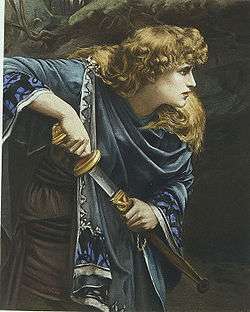
The play was adapted by Thomas d'Urfey as The Injured Princess, or, the Fatal Wager; this version was produced at the Theatre Royal, Drury Lane, presumably by the united King's Company and Duke's Company, in 1682.[33] The play changes some names and details, and adds a subplot, typical of the Restoration, in which a virtuous waiting-woman escapes the traps laid by Cloten. D'Urfey also changes Pisanio's character so that he at once believes in Imogen's (Eugenia, in D'Urfey's play) guilt. For his part, D'Urfey's Posthumus is ready to accept that his wife might have been untrue, as she is young and beautiful.[34] Some details of this alteration survived in productions at least until the middle of the century.
William Hawkins revised the play again in 1759. His was among the last of the heavy revisions designed to bring the play in line with classical unities. He cut the Queen, reduced the action to two places (the court and a forest in Wales).[35] The dirge "With fairest flowers..." was set to music by Thomas Arne.[36]
Nearer the end of the century, Henry Brooke wrote an adaptation which was apparently never staged.[37] His version eliminates the brothers altogether as part of a notable enhancement of Posthumus' role in the play.
George Bernard Shaw, who criticised the play perhaps more harshly than he did any of Shakespeare's other works, took aim at what he saw as the defects of the final act in his 1937 Cymbeline Refinished; as early as 1896, he had complained about the absurdities of the play to Ellen Terry, then preparing to act Imogen. He called it "stagey trash of the lowest melodramatic order". He later changed his view, saying it was "one of the finest of Shakespeare's later plays", but he remained convinced that it "goes to pieces in the final act".[38] Accordingly, in Cymbeline Refinished he rewrote the last act, cutting many of the numerous revelations and expositions, while also making Imogen a much more assertive figure in line with his feminist views.[39]
Screen adaptations
Elijah Moshinsky directed the BBC Television Shakespeare adaptation in 1983, ignoring the ancient British period setting in favour of a more timeless and snow-laden atmosphere inspired by Rembrandt and his contemporary Dutch painters. Richard Johnson, Claire Bloom, Helen Mirren, and Robert Lindsay play Cymbeline, his Queen, Imogen, and Jachimo, respectively, with Michael Pennington as Posthumus.[40]
In 2013, Ethan Hawke re-teamed with director Michael Almereyda to star in a film adaptation in which Hawke plays Iachimo.[41] The film was released under the title "Cymbeline (Anarchy)" and is set in the context of urban gang warfare. Ed Harris takes the title role. Penn Badgley plays the orphan Posthumus;[42] Milla Jovovich plays the role of the Queen;[43] Anton Yelchin is Cloten; and Dakota Johnson plays the role of Imogen.[44]
An operatic adaptation by American composer Christopher Berg exists;[45] scenes were performed in 2009.[46]
Cultural references
The 'Song' from Act II, Scene 3 (Hark, hark! the lark) was set to music by Franz Schubert in 1826.
Perhaps the most famous verses in the play come from the funeral song of Act IV, Scene 2, which begins:
- Fear no more the heat o' the sun,
- Nor the furious winter's rages;
- Thou thy worldly task hast done,
- Home art gone, and ta'en thy wages:
- Golden lads and girls all must,
- As chimney-sweepers, come to dust.
The first two lines are quoted by Virginia Woolf in Mrs. Dalloway by the two main characters Clarissa and Septimus Smith. The lines, which turn Mrs. Dalloway's thoughts to the trauma of the First World War, are at once an elegiac dirge and a profoundly dignified declaration of endurance. The song provides a major organisational motif for the novel.
The last two lines appear to have inspired T. S. Eliot in "Lines to a Yorkshire Terrier" (in Five-Finger Exercises). He writes:
- Pollicle dogs and cats all must
- Jellicle cats and dogs all must
- Like undertakers, come to dust.
The song was set to music by Roger Quilter as "Fear No More the Heat o' the Sun," No. 1 of Five Shakespeare Songs, Op. 23 (1921). It was also set by Gerald Finzi as part of his song cycle on texts by Shakespeare Let Us Garlands Bring (1942).
At the end of Stephen Sondheim's The Frogs, William Shakespeare is competing against George Bernard Shaw for the title of best playwright, deciding which of them is to be brought back from the dead in order to improve the world. Shakespeare sings the funeral song of Act IV, Scene 2, when asked about his view of death (the song is titled "Fear No More").
"Fear no more the heat of the sun" is the line that Winnie and her husband are trying to remember in Samuel Beckett's Happy Days as they sit exposed to the elements.
References
- ↑ Stanley Wells and Michael Dobson, eds., The Oxford Companion to Shakespeare Oxford University Press, 2001, p. 101.
- 1 2 Stanley Wells and Michael Dobson, eds., The Oxford Companion to Shakespeare Oxford University Press, 2001, p. vii.
- ↑ F. D. Hoeniger, "Two Notes on Cymbeline," Shakespeare Quarterly, Vol. 8, No. 1 (Winter, 1957), p. 133,
- ↑ Nosworthy, J. M. (1955) Preface in Cymbeline: Second Series p.xxiv quote:
... it's not possible to eliminate the debt to Boccaccio completely. The description of Imogen's bed-chamber, for instance, owes nothing to the English tale, but we have only to glance at the Decameron to discover a room in which a candle is burning, which is hung with pictures, all carefully noted by Ambrogiuolo, and to recognise at once a refinement of detail that stirred Shakespeare's imagination and set the poetry flowing from his pen.
- 1 2 Wells and Dobson, p. 101.
- ↑ Collier, S., Cutting to the heart of the matter, in Shakespearean Power and Punishment, ed. Kendall, G. M., (Fairleigh Dickinson Univ. Press, 1998), pg. 39
- ↑ F. E. Halliday, A Shakespeare Companion 1564–1964, Baltimore, Penguin, 1964; p. 366.
- ↑ "Secrets of Cymbeline". the neat-herd's daughter. Retrieved 9 February 2015.
- ↑ Kenneth Muir, Last Periods of Shakespeare, Racine, Ibsen, Wayne State University Press, Detroit, 1961, p.39
- 1 2 Strachey, Lytton. Books and Characters. New York: Harcourt, Brace, 1922: 64
- ↑ Harold Bloom, Shakespeare's Romances, Chelsea House, Philadelphia, 2000, p.2.
- ↑ Roger Warren (ed), William Shakespeare, Cymbeline, Clarendon Press: Oxford, 1998, p.91.
- ↑ Dobson and Wells, p. 103.
- ↑ Halliday, p. 125.
- ↑ Dowden, Edward, ed., Cymbeline (Indianapolis: Bowin-Merrill, 1899): xli.
- ↑ Odell, G. C. D., Shakespeare from Betterton to Irving (New York: Scribners, 1920): 94.
- ↑ Pollock, Frederick, editor, Macready's Reminiscences and Selections from His Diaries and Letters (New York: Macmillan, 1875): 526.
- ↑ Odell 596.
- ↑ White, Martin, Renaissance Drama in Action (London: Routledge, 1998): 213.
- ↑ Leiter 105.
- ↑ Leiter, Samuel, ed. Shakespeare Around the Globe (New York: Greenwood Press, 1986): 107.
- ↑ Trewin, J. C., Shakespeare on the English Stage, 1909–1964 (London: Barrie Rocklith, 1964): 305.
- ↑ Findlater, Richard, These Our Actors (London: Elm Tree Books, 1983): 18.
- ↑ Levin, Bernard. Daily Mail 18 July 1962.
- ↑ "Shakespeare in Great Britain, 1974" Shakespeare Quarterly 25 (1974): 391.
- ↑ Potter, Lois, "The 2001 Globe Season: Celts and Greenery," Shakespeare Quarterly 52 (2002): 100.
- ↑ Ajesh Patalay (30 August 2008). "Tom Hiddleston: Not just a Romeo". Telegraph.co.uk. Retrieved 9 February 2015.
- ↑ http://www.nytimes.com/2007/05/04/theater/reviews/04cymb.html?pagewanted=all
- ↑ http://www.phizzical.com/cymbeline-reviews/
- ↑ http://www.thepublicreviews.com/cymbeline-the-belgrade-theatre-coventry/
- ↑ https://www.thestage.co.uk/reviews/2014/cymbeline-5/
- ↑ http://bloggingshakespeare.com/reviewing-shakespeare/cymbeline-phizzical-grand-opera-house-belfast-2013/
- ↑ Odell 62.
- ↑ Spencer, Hazelton, Shakespeare Improved: The Restoration Versions in Quarto and on the Stage (Cambridge, Mass: Harvard University Press, 1927): 103–4.
- ↑ Dowden xli.
- ↑ Odell 262.
- ↑ Dowden xlii.
- ↑ Hart, Jonathan, Shakespeare and His Contemporaries, Palgrave Macmillan, 2011, p.170.
- ↑ Bernard F. Dukore, Bernard Shaw, Playwright: Aspects of Shavian Drama, University of Missouri Press, 1973, p.212
- ↑ "BFI Screenonline: Cymbeline (1983)". screenonline.org.uk. Retrieved 9 February 2015.
- ↑ "Ethan Hawke To Reunite With 'Hamlet' Director For Modern-Day 'Cymbeline'". Deadline.com. 31 July 2013. Retrieved 7 August 2013.
- ↑ "Penn Badgley Added To Shakespeare Adaptation 'Cymbeline'". Deadline.com. 7 August 2013. Retrieved 8 August 2013.
- ↑ "'Resident Evil's Milla Jovovich Joins Shakespeare Modernization 'Cymbeline'". Deadline.com. 8 August 2013. Retrieved 11 August 2013.
- ↑ "Anton Yelchin and Dakota Johnson Board Cymbeline". ComingSoon.net. 12 August 2013. Retrieved 13 August 2013.
- ↑ "Christopher Berg". Art Song Preservation Society of New York. Retrieved 9 February 2015.
- ↑ OPERA GROWS IN BROOKLYN. Retrieved February 9, 2015.
External links
- Cymbeline – Full text at M.I.T.
- Cymbeline – Flash Version
- Cymbeline – Modern version of the play.
- Cymbeline – HTML version.
- Cymbeline – Scene-indexed and searchable version of the text.
- Cymbeline – plain text from Project Gutenberg
- Cymbeline – different plain text edition
-
 Cymbeline public domain audiobook at LibriVox
Cymbeline public domain audiobook at LibriVox
.png)